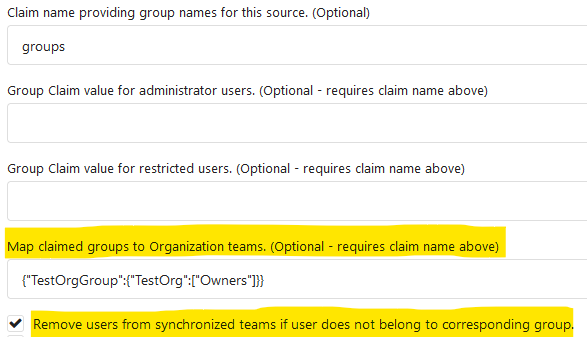Accessibility:
- improved semantic layout
- Fixes unlabelled input for custom pronouns. CC @hazy
- Adds labels to dropdowns.
- Shortens certain texts for less verbose screen reader outputs and
people with slow reading speed.
- Turned optional username rename helper text with low contrast into
"normal" help text.
UI/UX:
- Removes section about primary email which is no longer managed in the
profile section.
- Fixes section about primary email not displaying in user settings when notifications are
not available.
- Removes primary email display, because it is not actually a form
element here. (Alternatively, we could display it and link to the
account settings for managing the email)
(cherry picked from commit 2885ea8da2)
This commit has a fundamental flaw, in order to syncronize if external
users are still active the commit checks if the refresh token is
accepted by the OAuth provider, if that is not the case it sees that as
the user is disabled and sets the is active field to `false` to signal
that. Because it might be possible (this commit makes this a highly
likelyhood) that the OAuth provider still recognizes this user the
commit introduces code to allow users to re-active themselves via the
oauth flow if they were disabled because of this. However this code
makes no distinction in why the user was disabled and always re-actives
the user.
Thus the reactivation via the OAuth flow allows users to bypass the
manually activation setting (`[service].REGISTER_MANUAL_CONFIRM`) or if
the admin for other reasons disabled the user.
This reverts commit 21fdd28f08.
This leverages the existing `sync_external_users` cron job to
synchronize the `IsActive` flag on users who use an OAuth2 provider set
to synchronize. This synchronization is done by checking for expired
access tokens, and using the stored refresh token to request a new
access token. If the response back from the OAuth2 provider is the
`invalid_grant` error code, the user is marked as inactive. However, the
user is able to reactivate their account by logging in the web browser
through their OAuth2 flow.
Also changed to support this is that a linked `ExternalLoginUser` is
always created upon a login or signup via OAuth2.
Ideally, we would also refresh permissions from the configured OAuth
provider (e.g., admin, restricted and group mappings) to match the
implementation of LDAP. However, the OAuth library used for this `goth`,
doesn't seem to support issuing a session via refresh tokens. The
interface provides a [`RefreshToken`
method](https://github.com/markbates/goth/blob/master/provider.go#L20),
but the returned `oauth.Token` doesn't implement the `goth.Session` we
would need to call `FetchUser`. Due to specific implementations, we
would need to build a compatibility function for every provider, since
they cast to concrete types (e.g.
[Azure](https://github.com/markbates/goth/blob/master/providers/azureadv2/azureadv2.go#L132))
---------
Co-authored-by: Kyle D <kdumontnu@gmail.com>
(cherry picked from commit 416c36f3034e228a27258b5a8a15eec4e5e426ba)
Conflicts:
- tests/integration/auth_ldap_test.go
Trivial conflict resolved by manually applying the change.
- routers/web/auth/oauth.go
Technically not a conflict, but the original PR removed the
modules/util import, which in our version, is still in use. Added it
back.
When the ldap synchronizer is look for an email address and fails at
finding one, it falls back at creating one using "localhost.local"
domain.
This new field makes this domain name configurable.
Reviewed-on: https://codeberg.org/forgejo/forgejo/pulls/3414
Reviewed-by: Earl Warren <earl-warren@noreply.codeberg.org>
Co-authored-by: Baptiste Daroussin <bapt@FreeBSD.org>
Co-committed-by: Baptiste Daroussin <bapt@FreeBSD.org>
2 instances of `for` with a wrong value and 1 `for` that had a reference
to a `name` instead of `id`.
---------
Signed-off-by: Yarden Shoham <git@yardenshoham.com>
(cherry picked from commit 1d275c1748a75a01c270f5c306c5248808016aba)
Clarify when "string" should be used (and be escaped), and when
"template.HTML" should be used (no need to escape)
And help PRs like #29059 , to render the error messages correctly.
(cherry picked from commit f3eb835886031df7a562abc123c3f6011c81eca8)
Conflicts:
modules/web/middleware/binding.go
routers/web/feed/convert.go
tests/integration/branches_test.go
tests/integration/repo_branch_test.go
trivial context conflicts
Part of #27065
This reduces the usage of `db.DefaultContext`. I think I've got enough
files for the first PR. When this is merged, I will continue working on
this.
Considering how many files this PR affect, I hope it won't take to long
to merge, so I don't end up in the merge conflict hell.
---------
Co-authored-by: wxiaoguang <wxiaoguang@gmail.com>
Fix#21072

Username Attribute is not a required item when creating an
authentication source. If Username Attribute is empty, the username
value of LDAP user cannot be read, so all users from LDAP will be marked
as inactive by mistake when synchronizing external users.
This PR improves the sync logic, if username is empty, the email address
will be used to find user.
Fixes#19555
Test-Instructions:
https://github.com/go-gitea/gitea/pull/21441#issuecomment-1419438000
This PR implements the mapping of user groups provided by OIDC providers
to orgs teams in Gitea. The main part is a refactoring of the existing
LDAP code to make it usable from different providers.
Refactorings:
- Moved the router auth code from module to service because of import
cycles
- Changed some model methods to take a `Context` parameter
- Moved the mapping code from LDAP to a common location
I've tested it with Keycloak but other providers should work too. The
JSON mapping format is the same as for LDAP.

---------
Co-authored-by: Lunny Xiao <xiaolunwen@gmail.com>
There are 2 separate flows of creating a user: authentication and source
sync.
When a group filter is defined, source sync ignores group filter, while
authentication respects it.
With this PR I've fixed this behavior, so both flows now apply this
filter when searching users in LDAP in a unified way.
- Unified LDAP group membership lookup for authentication and source
sync flows
- Replaced custom group membership lookup (used for authentication flow)
with an existing listLdapGroupMemberships method (used for source sync
flow)
- Modified listLdapGroupMemberships and getUserAttributeListedInGroup in
a way group lookup could be called separately
- Added user filtering based on a group membership for a source sync
- Added tests to cover this logic
Co-authored-by: Pavel Ezhov <paejov@gmail.com>
Co-authored-by: Lunny Xiao <xiaolunwen@gmail.com>
Change all license headers to comply with REUSE specification.
Fix#16132
Co-authored-by: flynnnnnnnnnn <flynnnnnnnnnn@github>
Co-authored-by: John Olheiser <john.olheiser@gmail.com>